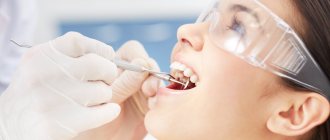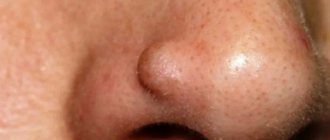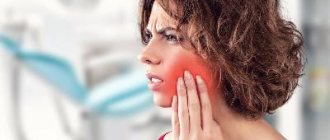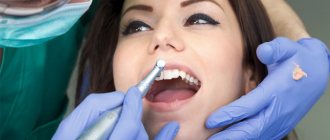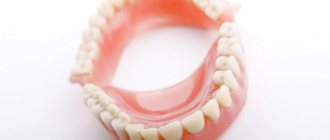Ball in mouth - what is it?
When the inflammation begins to gradually progress, a blister appears on the gum. The main reason for the formation of a lump is poor oral hygiene and prevention. But the ball can also form under the influence of other factors: inflammation occurring in the roots of the teeth, gums, mucous membranes, and periosteum.
The problem is that the disease can be diagnosed in the later stages, with the development of a purulent process. This happens because the patient does not visit the dentist. For patients who experience fear while in a chair, the doctor can give sedative anesthesia, in which the receptors are turned off and the patient falls into a shallow sleep.
Attention! It is better to diagnose the disease early in order to prevent more dangerous consequences, including blood infection and inflammation of the entire jaw.
Treatment options for acne and bumps on the chin
Today, modern medicine provides us with completely different means available to treat acne on the chin.
The methods and duration of treatment prescribed by dermatologists usually depend on the severity of your symptoms, and are adjusted depending on whether you plan to have a child.
Here are some of the most common treatment options:
Hormone therapy
Some medications intended for pregnancy prevention and birth control can lead to problems related to hormonal imbalance and disruption of sex hormone regulation, which in most cases leads to acne on the face and chin.
In order to avoid the consequences of the problem and adjust the level of female hormones in the body, take medications containing estrogen and progesterone, such as Trimaran - Cyclen Ortho, Yaz and Estrostep, which have all been approved by the Ministry of Health of Russia and the EU.
In practice, the drugs have proven to be quite useful for women whose bodies produce too many male hormones. In addition, to get rid of hormonal acne on the chin, try hormone replacement therapy, but only after consulting with your doctor.
Prevention and treatment
A good diet, regular eating and weight control, breaking bad habits are all vital steps towards treating acne and bumps on the chin.
If you are obese, then losing weight may be the best solution to your acne problem. A little weight loss goes a long way in balancing your hormonal levels and getting your menstrual cycle back on track.
Include plenty of fruits, whole grains, vegetables and low-fat dairy products in your daily diet.
If you smoke, seriously consider quitting the habit. Smokers always have higher androgen levels and a greater tendency to develop various diseases than people who do not smoke.
Hormone therapy can help with excessive hair growth and acne. Androgen-lowering spironolactone (Aldactone) is commonly prescribed by doctors as part of a complete treatment for chin bumps. This approach can help treat acne and even hair loss.
Subcutaneous acne on the chin
Use of antibiotics
If you're suffering from itchy, painful, bumpy pimples on your chin and nothing is helping, antibiotic acne medications may be the answer.
They will help to significantly reduce inflammation, as well as destroy the bacteria that caused acne, however, provided that you first receive a prescription and recommendations from your doctor, and you strictly adhere to the instructions and recommendations in using any antibiotic against acne.
Creams, lotions, ointments, gels against acne
Lotions, gels, creams and ointments prescribed by your doctor can be excellent helpers in the complex treatment of acne on the chin.
Typically, doctors recommend products that contain a retinoid (a form of vitamin A), found in some creams, gels, and ointments, which can cleanse the pores of your face of excess subcutaneous oil, thereby significantly helping the antibiotics you use to have positive effect as quickly and reliably as possible.
Maintain strict personal hygiene
- Wash your face using cleansing scrubs and lotions regularly twice a day (after waking up and before going to bed). You should wash your face more than 2 times only if it is very dirty, or if the skin becomes significantly oilier.
- Use soft, lukewarm water, as hard cold or hot water tends to block sebaceous ducts and pores.
- You can soften your water at home by purchasing suitable water filters and a softening system that will help you filter the water and balance its chemical and biological composition.
- Do not touch or rest your chin with your hands, as this can significantly introduce dirt and bacteria into the pores.
- Avoid picking or squeezing pimples on your chin, especially if they are bumps.
Home Remedies for Acne on Chin (with Instructions)
Ice
Ice can be used to quickly relieve swelling, redness and inflammation of pimples. Using ice increases the return of blood flow from the acne area by freezing the pimples on the skin.
Wrap a piece of ice in a cloth or gauze, place it on the pimple-affected area of your chin, and hold it there for a few seconds.
Afterwards, take a short break of a few minutes and then repeat the procedure.
Lemon
Another easy way to get rid of blemishes and pimples is lemon juice, which is rich in vitamin C. Lemon juice will dry out pimples quickly. Dip a cotton swab into the freshly squeezed juice, then wipe the pimples three times.
Acne on the chin in women
Garlic
The sulfur in garlic also causes acne to heal quickly.
- Cut a fresh garlic clove into two halves.
- Apply garlic to the pimple, wipe the affected area with it, and leave it for five minutes, then rinse with lukewarm water.
- Repeat the treatment many times every day until you achieve the expected result. Also, eating 1 clove of garlic every day will help cleanse your blood and significantly improve the condition and appearance of your skin. But do not overdo it - you should not eat too much raw garlic, as it can cause digestive problems.
Why does a lump appear on the gum?
The accumulation of conditionally pathogenic and pathogenic microflora due to improper oral care leads to inflammation of the mucous membrane. Other reasons why a ball appears on the gum include:
- chemical, thermal or mechanical trauma to the periodontium;
- carious formations and their complications: periodontitis, pulpitis;
- inflammation of the wisdom tooth;
- eruption of molars;
- jawbone overgrowth;
- weak immune system;
- infectious pathologies of the oral cavity: herpes, candidiasis, stomatitis.
A lump in the mouth also occurs under other conditions: epulis, exostosis, fibroma, focal fibromatosis, malignancy, cyst and flux. The main thing is to promptly establish the causes of the pathology and begin treatment.
If the ball in your mouth does not cause discomfort
The color of the bubble will help the doctor make a diagnosis. A white lump on the gum indicates the presence of exostosis or purulent exudate. A red or bloody ball indicates the development of inflammation. If the growth matches the shade of the tissue, it is the initial stage of epulis, flux, or a malignant tumor. When the tumor does not hurt, this indicates the presence of one of the pathologies:
A fistula is a white ball on soft tissues that appears under or on a tooth. There is a hole on the surface for the release of pus. If, when pressed, suppuration flows out of the bladder, the patient does not feel pain. If the hole is closed with pus or bloody clots, the patient will experience discomfort with any impact.
A fistula is often formed due to advanced periodontitis, accompanied by periodontal hyperplasia. Overgrown tissue is good soil for the proliferation of microorganisms. In this case, the patient urgently needs treatment for periodontitis.
In the absence of therapy, the fistula enters a chronic stage, which can only be eliminated through surgical treatment. The progression of the disease must not be allowed, otherwise you may lose healthy molars.
Hematoma is a round lump on the inner surface of the cheek. Sometimes it occurs in the form of a dark bluish swelling on top of the gums. Blood accumulates in or around the root of the molar. The mucous membrane grows, the patient experiences discomfort and cannot completely close the jaw. The main reasons: consequences of filling or tooth extraction, gum damage, poor blood clotting.
Hematomas are generally not dangerous. Processes take place in the body through which soft tissues are cleared of bloody clots. After some time, the bubble disappears, but if the seal remains, you need to visit a dental clinic.
Exostosis is a hard blister that is an abnormality in which the bones protrude and protrude from the jaw. Gradually, the lump increases in volume, which causes discomfort and pain. Exostosis can be provoked by various reasons:
- jaw damage;
- heredity;
- congenital disorders;
- tissue diseases after molar removal.
An examination by a dentist or an x-ray will help detect the disease. The formation will need to be removed if the development of a malignant tumor is suspected.
Epulis is a pedunculated bubble in the form of a mushroom-shaped growth on the periodontium. The tumor may be the same color as the gums or red. The reasons causing the development of pathology include:
- improper filling of the molar or too large a filling;
- dental plaque, stone;
- jaw damage;
- malocclusion;
- hormonal imbalance;
- poor prosthetic material or incorrect prosthetics.
The symptoms of epulis resemble gingivitis; for diagnosis, the dentist prescribes radiography and histology to the patient. With their help, the degree of destruction of bone tissue at the site of the epulis lesion is determined. Mostly, pathology occurs in children during the growth of primary molars and in women.
Papilloma or fibroma is a bubble on the gum, sometimes a benign formation that does not pose a threat to the health or life of the patient. They are formed in people of different genders and ages. Predisposing factors to the appearance of a lump can be: damage to the mucosa, stress, systemic pathologies, heredity.
Papilloma is an enlargement of the papillary layer of skin. The bubble grows gradually, but with reduced immunity, systemic pathology, or stress, growth accelerates, but without turning into a malignant tumor. A papilloma neoplasm looks like a smooth, soft lump on the mucous membrane of a white or pink shade on a thin stalk.
Papilloma often does not create any discomfort. But after some time it may increase in size. You should consult a dentist and get tested.
Causes of acne on the chin
Acne on the chin (as well as in other areas of the body such as the nose or roof of the mouth) can be caused by a variety of factors. We'll tell you about the most common ones.
Poor nutrition
First of all, acne on the chin may indicate that there is a junk food in your diet that is causing your acne, or perhaps a food allergy is present. People who are prone to allergic reactions to certain foods and do not have a balanced diet are most likely to suffer from spots and pimples on their chin This is because acne on the chin is associated with disorders in the small intestine, especially those caused by food allergies or an unhealthy diet.
Hormonal imbalance
Secondly, acne may be caused by hormonal changes if it appears during your menstrual cycle, pregnancy or menopause, or during puberty. For example, your body may be prone to pimples will begin to appear, and when finished they will gradually begin to disappear.
Polycystic ovarian syndrome
In this case, the level of sex hormones is not normal. Usually the ovaries produce small amounts of male sex hormones (androgens). In polycystic ovarian syndrome, the androgen level is slightly elevated. This can lead to the cessation of ovulation, as well as the appearance of acne and the growth of additional hair on the face and body.
Accumulation of toxic substances in the body
In this case, your body is unable to get rid of toxic substances. The accumulation of these toxins can lead to acne on the chin.
Stress
You must have noticed that during stressful situations, when you are nervous or worried, such as before a date or an important exam, your skin condition can generally worsen, and with anxiety and stress comes acne.
The exact cause is not yet known, but since the cells that produce subcutaneous fat have receptors and nerve endings, there is some sort of connection between stress and acne.
If you lead a busy lifestyle, you also become prone to developing pimples on your chin. They can multiply from a moderate amount to a very large amount, depending on your level of anxiety. Stress caused by family problems, social or professional life is enough to cause sudden changes in the amount. acne on your face, especially in the chin area.
Insufficient personal hygiene
Not paying enough attention to personal hygiene can cause acne to appear on a larger scale than before, as well as worsen the condition of existing acne.
Frequently touching the skin of your chin and neck with a dirty mobile phone, especially if you have a habit of holding your mobile phone against your chin and neck and have frequent and prolonged conversations, can expose acne-causing germs to your mobile devices. , will cause the formation of more and more acne on the chin and face.
Likewise, dirty musical instruments such as the violin can cause acne if they come into frequent contact with your chin.
Do not touch your face or chin with dirty hands, and do not prop your face or chin with your elbow, or support your head with your hands.
Internal pimple on chin photo
If the formation on the gum causes discomfort
If a bubble near a molar causes pain, this indicates an infectious inflammatory process. Discomfort is also typical with gum injuries and hematomas. Painful formations can be caused by a cyst, cancer, fibroma, periostitis, periodontitis.
Gingivitis - the disease affects only one gum, and the periodontium near the molar remains uninjured. The main symptoms of the pathology are swelling, bleeding, and peeling of the epithelium. Gingivitis often occurs against the background of halitosis. Sometimes pathology develops as a result of endocrine and metabolic disorders.
When treating, it is necessary to eliminate the cause of gingivitis. Professional oral hygiene, diagnosis and treatment of metabolic disorders are performed. To eliminate inflammation and prevent further spread of bacteria, antibiotic therapy is administered. For pain and severe discomfort, analgesics are prescribed.
Periodontitis - purulent bumps on the gums appear as a result of degeneration of the alveolar process, through which the tooth root is held in the alveolus. Tissues can be destroyed due to poor oral hygiene and internal pathologies.
In the initial stages, periodontitis is treated by teeth cleaning at the dental clinic and further proper care. An advanced form of the disease, in which the teeth become loose, pus accumulates, requires surgical intervention - restoration of the alveolar processes or removal of molars.
Periostitis or flux is a dense formation near a problematic molar with carious lesions. Patients complain of pain radiating to the temple, chest, neck, ear. The condition gradually worsens and the temperature can rise to 38 degrees. In the oral cavity, lesions due to periostitis are hyperemic. A purulent fistula forms. When the discharge is removed, the discomfort decreases.
Causes of periostitis: trauma, periodontitis, osteomyelitis, weak immune system, infectious pathologies occurring in the body and vitamin deficiency.
Other causes of acne and bumps on the chin
Poll: When did your acne appear? (Number of votes: 4295)
I've been suffering all my life
It's been a couple of years now
About a few months
Recently
To vote, click on the desired answer. results
The appearance of bumpy acne on the chin can be caused by suddenly stopping the use of birth control pills, due to which hormonal changes in the body can lead to the appearance of spots and bumps on the chin.
Excessive sweating causes subcutaneous sebum to clog pores and cause acne on the chin.
A poor diet consisting of foods low in vitamins and nutrients can also lead to acne breakouts.
Smokers are more vulnerable to sudden changes in skin condition and the appearance of acne in the form of bumps and spots on the chin.
Very rarely, infections such as rosacea, discoid erythematous lupus, warts, facial dermatomycosis, abscess, insect bites, herpes, boils, moles, melanoma, actinic keratosis, perioral dermatitis, and some other infections can also cause pimples, spots or bumps on your chin.
Treatment of neoplasms in the oral cavity
A lump under the jaw or on the gum can be detected upon examination. For an accurate diagnosis, a biopsy or x-ray is prescribed. Treatment is selected taking into account the cause of the formation of a bubble in the oral cavity. It will be necessary to stop the further spread of infection and eliminate discomfort.
The doctor will determine how to remove the lump after a complete diagnosis, but the main measures include:
- fistula - pus is removed by rinsing with a disinfectant solution;
- epulis - surgical intervention (removal using diathermocoagulation, cryodestruction or a scalpel);
- periodontitis - removing fillings, cleaning canals, removing pus, rinsing with herbal decoctions and soda solution;
- periostitis - placement of special drugs under a temporary filling (if there is no result, the tooth will have to be removed);
- gingivitis - cleaning of periodontal tubules, antiseptic and antibacterial therapy, removal of lumps.
When a formation appears on the gum, you can rinse your mouth with vodka, diluted alcohol or juice from fresh Kalanchoe leaves.
Timely diagnosis allows you to prevent further spread of infection and save teeth.
Only an experienced dentist will help you get rid of a lump in your mouth, minimizing the risk of developing serious complications. At the first signs of pathology, you should immediately consult a doctor. The doctor's consultation
